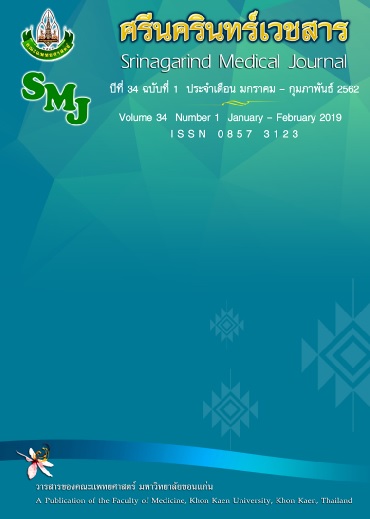ความสัมพันธ์ของปัจจัยการรอดชีวิตของผู้บาดเจ็บจากอุบัติเหตุจราจรที่เข้ารับการรักษา ณ โรงพยาบาลระดับตติยภูมิแห่งหนึ่งในจังหวัดภูเก็ต
คำสำคัญ:
การดูแลผู้บาดเจ็บ; ระยะเวลานำส่งโรงพยาบาล; ความรุนแรงของการบาดเจ็บ; อุบัติเหตุจราจร; ระบบการแพทย์ฉุกเฉินบทคัดย่อ
หลักการและวัตถุประสงค์: อุบัติเหตุจราจรเป็นปัญหาสาธารณสุขของประเทศไทยที่ส่งผลต่อการบาดเจ็บ พิการและสูญเสียชีวิต การศึกษานี้ต้องการเปรียบเทียบปัจจัยที่อาจมีความสัมพันธ์กับการรอดชีวิตของผู้บาดเจ็บจากอุบัติเหตุจราจรที่โรงพยาบาลระดับตติยภูมิแห่งหนึ่งในจังหวัดภูเก็ต
วิธีการศึกษา: ศึกษาข้อมูลทุติยภูมิย้อนหลังจากข้อมูลระบบการแพทย์ฉุกเฉินและข้อมูลบันทึกการเฝ้าระวังการบาดเจ็บของโรงพยาบาลตติยภูมิในจังหวัดภูเก็ต ตั้งแต่ 1 มกราคม 2556 ถึง 31 ธันวาคม 2558 และวิเคราะห์ข้อมูลด้วยสถิติพรรณนา สถิติ Chi Square, Mann Whitney U test และ Multiple Logistic Regressionโดยใช้โปรแกรม SPSS version 18
ผลการศึกษา: ผู้บาดเจ็บอุบัติเหตุจราจร 2,067 ราย เป็นเพศชายมากกว่าเพศหญิง (สัดส่วน 2:1) ร้อยละ 35.3 อายุ16 - 25 ปี พาหนะที่เกิดอุบัติเหตุสูงสุด ร้อยละ 90.8 คือรถจักรยานยนต์ เมื่อเปรียบเทียบปัจจัยความแตกต่างระหว่างผู้รอดชีวิตและผู้เสียชีวิตพบว่า 1) ระยะเวลาที่ได้รับปฏิบัติการฉุกเฉิน (Response time) 2) Revise Trauma Score (RTS) 3) Injury Severity Score (ISS) และ4) Probability of Survivor (Ps) มีความแตกต่างอย่างมีนัยสำคัญทางสถิติ (p < 0.05) และ Revise Trauma Score (RTS) มีความสัมพันธ์กับการรอดชีวิตอย่างมีนัยสำคัญทางสถิติ (OR 3.33 95 % CI 2.22–5.06)
สรุป: ระยะเวลาที่ได้รับปฏิบัติการฉุกเฉิน (Response time) คะแนนความรุนแรงการบาดเจ็บ Revise Trauma Score (RTS) , Injury Severity Score (ISS) และ Probability of Survivor (Ps) ของผู้รอดชีวิตมีค่าแตกต่างกับผู้เสียชีวิตและ Revise Trauma Score (RTS) เป็นเพียงปัจจัยเดียวที่มีความสัมพันธ์กับการรอดชีวิต
เอกสารอ้างอิง
Available from http://www.who.int/mediacentre/factsheets/fs358/en/.
. World Health Organization. Global Status report on road Safety 2015 [cited October 12, 2016]. Available from http://www. who.int/violence_injury_prevention/road_safety_status,
. กระทรวงสาธารณสุข, กองยุทธศาสตร์และแผนงาน. สถิติสาธารณสุข พ.ศ. 2559 จังหวัด [เข้าถึงเมื่อ 9 เมษายน 2561]. เข้าถึงจาก http://bps.moph.go.th/new_bps/sites/default/files/health_strategy2559.pdf
. ประณีต ส่งวัฒนา. กระบวนการดูแลผู้บาดเจ็บต่อเนื่อง. วารสารมหาวิทยาลัยนราธิวาสราชนครินทร์ 2555; 4: 102-14.
. สถาบันการแพทย์ฉุกเฉินแห่งชาติ. แผนหลักการแพทย์ฉุกเฉินแห่งชาติ ฉบับที่ 2 พ.ศ. 2556 -2559. กรุงเทพฯ: ไม่ระบุสถานที่พิมพ์; 2555.
. ไพบูลย์ สุริยะวงศ์ไพศาล, วรสิทธิ์ ศรศรีวิชัย,นิสิต วรรธนัจฉริยา และคณะ. รายงานประเมินนโยบายว่าด้วยวิวัฒนาการระบบการแพทย์ฉุกเฉิน. กรุงเทพฯ: ภาควิชาเวชศาสตร์ชุมชน คณะแพทยศาสตร์โรงพยาบาลรามาธิบดี; 2556.
. ประจักษวิช เล็บนาค, กรองกาญจน์ บุญใจใหญ่, ตรึงตา พูลอำนวย และคณะ. รายงานการศึกษาประสิทธิผลและความคุ้มค่าของการปฏิบัติการฉุกเฉินอย่างทันท่วงที. นนทบุรี: สถาบันการแพทย์ฉุกเฉิน; 2558.
. Gruen RL, Gabbe BJ, Stelfox HT, Cameron PA. Indicators of the quality of trauma care and the performance of trauma systems. Br J Surg 2012; 99(suppl1): 97-104.
. อุบล ยี่เฮ็ง. การจัดการและการช่วยเหลือผู้บาดเจ็บจากอุบัติเหตุในระยะก่อนถึงโรงพยาบาล. ใน:อนันต์ ตัณมุขยกุล, เรวัฒชุณหสุวรรณกุล,พรพรหม เมืองแมน, บรรณาธิการ. ศัลยศาสตร์วิวัฒน์ 40. พิมพ์ครั้งที่ 1. กรุงเทพฯ: เอ็น พี เพรส ลิมิเต็ดพาร์เนอร์ชิพ; 2554.
. Feero S, Hedges JR, Simmons E, Irwin L. Does out-of-hospital EMS time affect trauma Survival?. Am J Med 1995; 13: 133-5.
. Sánchez-Mangas R, García-Ferrrer A, de Juan A, Arroyo AM. The probability of death in road traffic accidents. How important is a quick medical response? Accident Anal Prev 2010; 42: 1048-56.
. Gonzalez RP, Cummings GR, Phelan HA, Mulekar MS, Rodning CB. Does increased emergency medical services prehospital time affect patient mortality in rural motor vehicle crashes? A statewide analysis. Am J Surg 2009; 197: 30-4.
. Pons PT, Markovchick VJ. Eight minutes or less: does the ambulance response time guideline impact trauma patient outcome?. J Emerg Med 2002; 23: 43-8.
. Brown JB, Rosengart MR, Forsythe RM, Reynolds BR, Gestring ML, Hallinan WM, et al. Not All Prehospital Time is Equal: Influence of Scene Time on Mortality. J. Trauma Acute Care Surg 2016; 81: 93-100.
. Chawda MN, Hildebrand F, Pape HC, Giannoudis PV. Predicting outcome after multiple trauma: which scoring system? Injury 2004; 35: 347-58.
. Roy N, Gerdin M, Schneider E, Veetil DKK, Khajanchi M, Kumar V, et al. Validation of international trauma scoring systems in urban trauma centres in India. Injury 2016; 47: 2459-64.
. Najafi Z, Zakeri H, Mirhaghi A. The accuracy of acuity scoring tools to predict 24-h mortality in traumatic brain injury patients: A guide to triage criteria. Int Emerg Nurs 2018; 36: 27-33.
. Alghnam S, Palta M, Hamedani A, Alkelya M, et al. Predicting in-hospital death among patients injured in traffic crashes in Saudi Arabia. Injury 2014; 45: 1693-9.
. Lerner EB, Moscati RM. The golden hour: scientific fact or medical "urban legend"?. Acad Emerg Med. 2001; 8: 758-60.
. Champion HR, Sacco WJ, Carnazzo AJ, Copes W, Fouty WJ. Trauma score. Crit care Med 1981; 9: 672-6.




